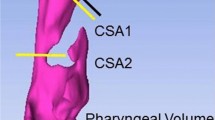Abstract
The objective of the study was to investigate the relationship between lingua–epiglottis position and glossopharyngeal obstruction in patients with obstructive sleep apnea hypopnea syndrome (OSAHS). One hundred and four patients with OSAHS diagnosed by polysomnography (PSG) were enrolled. Lingua–epiglottis position was visualized using endoscopy and classified into three types. Spiral CT imaging of the upper respiratory tract was performed to measure the cross-sectional area and inner diameter of the glossopharyngeal airway. The PSG was repeated after nasopharyngeal tube insertion (NPT-PSG). The NPT-PSG results, CT-measured data and incidence of stenosis were compared among the different lingua–epiglottis position groups. Obstructive sleep apnea hypopnea syndrome patients with different lingua–epiglottis positions had similar demographics. As lingua–epiglottis position type varied from type I to type III, cross-sectional area and inner diameter of the glossopharyngeal area decreased, glossopharyngeal airway stenosis rate increased, and apnea hypopnea index measured by NPT-PSG increased. The lowest oxygen saturation decreased. Lingua–epiglottis position was significantly related to glossopharyngeal obstruction. Lingua–epiglottis position should be used in clinical practice for the preliminary assessment of glossopharyngeal obstruction.



Similar content being viewed by others
References
Isono S, Remmers JE (1994) Anatomy and physiology of upper airway obstruction. In: Kryger HH (ed) Principles and practice of sleep medicine, 2nd edn. Saunders, Philadelphia, pp 642–656
Tanyeri H, Serin GM, Ayanoglu EA, Polat S, Cuhadaroglu C (2013) Effect of uvulopalatopharyngoplasty on retropalatal region. Eur Arch Otorhinolaryngol 270(3):1161–1165
Braga A, Carboni LH, do Lago T, Kipper DS, Eckeli A, Valera FC (2013) Is uvulopalatopharyngoplasty still an option for the treatment of obstructive sleep apnea? Eur Arch Otorhinolaryngol 270(2):549–554
Friedman M, Ibrahim H, Joseph NJ (2004) Staging of obstructive sleep apnea/hypopnea syndrome: a guide to appropriate treatment. Laryngoscope 114(3):454–459
Soares D, Folbe AJ, Yoo G, Badr MS, Rowley JA, Lin HS (2013) Drug-induced sleep endoscopy vs awake Muller’s maneuver in the diagnosis of severe upper airway obstruction. Otolaryngol Head Neck Surg 148(1):151–156
Singh A, Al-Reefy H, Hewitt R, Kotecha B (2008) Evaluation of ApneaGraph in the diagnosis of sleep-related breathing disorders. Eur Arch Otorhinolaryngol 265(12):1489–1494
Demin H, Jingying Y, Jun W, Qingwen Y, Yuhua L, Jiangyong W (2002) Determining the site of airway obstruction in obstructive sleep apnea with airway pressure measurements during sleep. Laryngoscope 112(11):2081–2085
Bachar G, Nageris B, Feinmesser R, Hadar T, Yaniv E, Shpitzer T, Eidelman L (2012) Novel grading system for quantifying upper-airway obstruction on sleep endoscopy. Lung 190(3):313–318 (Epub 2012 Jan 20)
Tang XL, Yi HL, Luo HP, Xiong YP, Meng LL, Guan J, Chen B, Yin SK (2012) The application of CT to localize the upper airway obstruction plane in patients with OSAHS. Otolaryngol Head Neck Surg 147(6):1148–1153
Li S, Dong X, Shi H, Dong W, Qu S, Chen D, Wang G, Bao J (2002) Localization of upper airway stricture in patients with obstructive sleep apnea syndrome by CT scan. Chin J Otorhinolaryngol 37(2):133–136 (Chinese)
Li S, Shi H (2013) Lingual artery CTA-guided midline partial glossectomy for treatment of obstructive sleep apnea hypopnea syndrome. Acta Otolaryngol 133(7):749–754
Iber C, Ancoli-Israel S, Chesson AL, Quan SF (2007) The AASM manual for the scoring of sleep and associated events: rules, terminology and technical specifications. American Academy of Sleep Medicine, Westchester, p 57
Li SH, Wu DH, Bao JM, Shi HJ (2013) Outcomes of upper airway reconstructive surgery for obstructive sleep apnea syndrome based on polysomnography after nasopharyngeal tube insertion. Chin Med J (Engl) 126(24):4674–4678
Li S, Wu D, Shi H (2013) Treatment of obstructive sleep apnea hypopnea syndrome caused by glossoptosis with tongue-base suspension. Eur Arch Otorhinolaryngol 270(11):2915–2920
Soares D, Sinawe H, Folbe AJ, Yoo G, Badr S, Rowley JA, Lin HS (2012) Lateral oropharyngeal wall and supraglottic airway collapse associated with failure in sleep apnea surgery. Laryngoscope 122(2):473–479
Li SH, Shi HJ, Wu DH, Dong WD, Zou LG, Liu R (2007) Relationship of lingual region upper airway stricture and lingua–palate position type in obstructive sleep apnea hypopnea syndrome patients. Chin J Otorhinolaryngol 42(12):910–914 (Chinese)
Acknowledgments
No financial disclosures.
Conflict of interest
None.
Author information
Authors and Affiliations
Corresponding author
Rights and permissions
About this article
Cite this article
Li, S., Wu, D., Jie, Q. et al. Lingua–epiglottis position predicts glossopharyngeal obstruction in patients with obstructive sleep apnea hypopnea syndrome. Eur Arch Otorhinolaryngol 271, 2737–2743 (2014). https://doi.org/10.1007/s00405-014-3033-3
Received:
Accepted:
Published:
Issue Date:
DOI: https://doi.org/10.1007/s00405-014-3033-3




